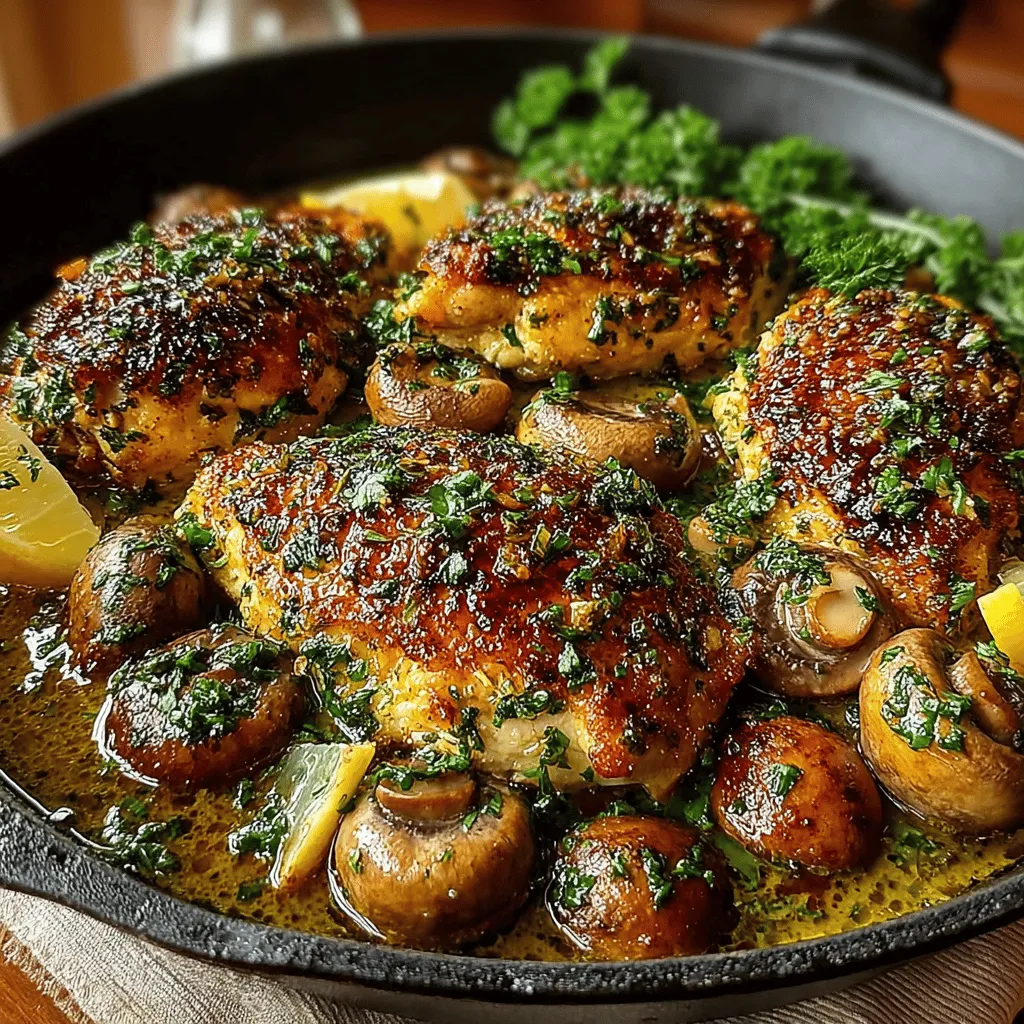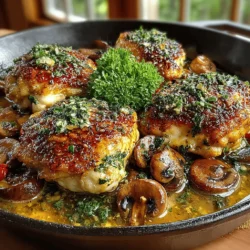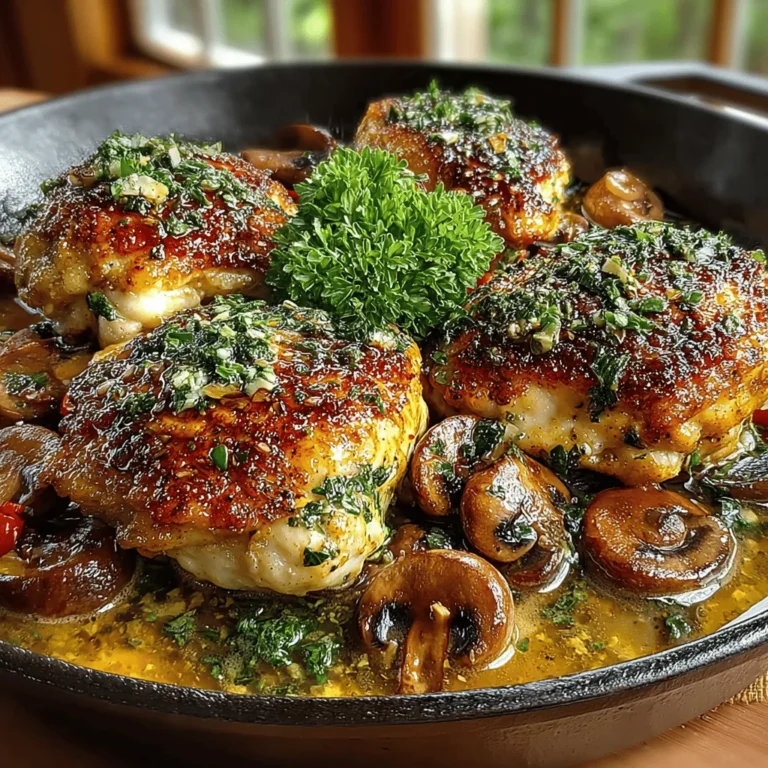Introduction to Savory Chicken Marsala Skillet Delight
Chicken Marsala is a beloved classic in Italian cuisine, celebrated for its rich flavors and comforting appeal. This dish typically features tender chicken breasts cooked in a luscious sauce made with Marsala wine, creating a delightful balance of savory and slightly sweet notes. While traditional Chicken Marsala is often made as a more intricate preparation, our Savory Chicken Marsala Skillet Delight simplifies the process, making it an ideal choice for weeknight dinners or gatherings with family and friends.
The allure of a skillet recipe lies in its speed and convenience. With just one pan, you can create a meal that feels gourmet without spending hours in the kitchen. This method allows for quick cooking and easy cleanup, making it perfect for busy lifestyles. The Savory Chicken Marsala Skillet Delight is not only efficient but also packed with flavor, promising a dish that is savory, rich, and aromatic.
To achieve the best results, it is crucial to use high-quality ingredients and follow proper cooking techniques. The interplay of fresh ingredients enhances the overall taste, ensuring that each bite is a delightful experience.
Understanding the Ingredients
Every ingredient in the Savory Chicken Marsala Skillet Delight plays a vital role, contributing to the dish’s overall flavor and texture. Let’s explore each component that comes together to create this irresistible meal.
Chicken Breasts
The star of our dish is boneless, skinless chicken breasts. They are an excellent choice due to their lean protein content and ease of cooking. Using boneless chicken not only reduces cooking time but also ensures that the meat remains juicy and tender throughout the cooking process. By removing the skin, we can focus on the flavors from the sauce and seasonings without the added fat. Properly preparing the chicken is essential for achieving a golden-brown crust and locking in moisture, which will be discussed further in the preparation section.
Seasonings
Seasonings are the backbone of any great dish, and in our Chicken Marsala, we rely on salt, pepper, and garlic powder to elevate the flavors. Salt enhances the natural taste of the chicken and other ingredients, while pepper adds a subtle heat. Garlic powder contributes an aromatic depth that complements the overall profile of the dish, ensuring that each bite is packed with flavor. The right balance of these seasonings can make a significant difference, so don’t hesitate to adjust according to your personal preferences.
Mushrooms
Mushrooms are another essential ingredient in this recipe, lending both texture and an earthy flavor to the dish. Cremini or button mushrooms are preferred choices for this recipe. Cremini mushrooms, also known as baby bellas, offer a deeper flavor than their button counterparts, which are milder and slightly sweeter. Their firm texture holds up well during cooking, adding a satisfying bite that contrasts beautifully with the tender chicken. Sautéing the mushrooms until they are golden brown will bring out their natural umami flavor, further enhancing the dish.
Marsala Wine
Marsala wine is the defining ingredient that sets Chicken Marsala apart from other chicken dishes. This fortified wine from Sicily adds a unique sweetness and depth to the sauce. The flavor of Marsala can range from dry to sweet, so selecting the right type for your palate is important. When cooked, the alcohol evaporates, leaving behind a rich, complex flavor that beautifully coats the chicken and mushrooms. It’s a key player in achieving that signature taste that makes Chicken Marsala so beloved.
Chicken Broth
To enrich the sauce, chicken broth is added. This ingredient not only helps to deglaze the pan, capturing all the flavorful bits left from searing the chicken and sautéing the mushrooms, but it also adds depth to the overall sauce. A good-quality broth will enhance the savory notes of the dish, creating a well-rounded flavor profile. When selecting chicken broth, opt for low-sodium versions to control the saltiness of the final dish.
Garlic and Parsley
Garlic and fresh parsley are the finishing touches that brighten the dish. Garlic, with its aromatic properties, enhances the overall flavor and complements the earthiness of the mushrooms. Fresh parsley not only adds a burst of color but also provides a fresh, herbal note that balances the richness of the sauce. Additionally, parsley is known for its health benefits, including being a good source of vitamins A, C, and K.
Preparation of Chicken
Before diving into the cooking process, preparing the chicken properly is essential for achieving the best results. Start by selecting high-quality boneless, skinless chicken breasts, ensuring they are fresh and free from any blemishes.
Patting Dry and Seasoning
The first step in preparation is to pat the chicken breasts dry with paper towels. This step is crucial as it removes excess moisture, which can prevent the chicken from achieving a golden-brown crust during searing. Once dried, season the chicken generously with salt, pepper, and a sprinkle of garlic powder. This seasoning not only enhances the flavor of the chicken but also infuses it with aroma, creating a delicious foundation for the dish.
Even Cooking and Achieving a Golden-Brown Crust
For the best texture, it’s important to ensure that the chicken breasts are of uniform thickness. If necessary, you can butterfly thicker pieces or gently pound them to an even thickness. This step promotes even cooking, reducing the risk of dry, overcooked edges while the center remains undercooked. The goal is to achieve a perfectly cooked chicken breast that is juicy and tender on the inside, with a satisfying golden-brown crust on the outside.
Searing the Chicken
Once the chicken is prepped and seasoned, it’s time to sear it to lock in those flavors. Searing is a technique that involves cooking the surface of the meat at a high temperature, creating a delicious caramelized crust that enhances the overall flavor of the dish.
Technique of Searing
To begin, heat a large skillet over medium-high heat and add a splash of olive oil. The oil should shimmer but not smoke; this indicates that it is hot enough for searing. Carefully add the chicken breasts to the skillet, ensuring not to overcrowd the pan, as this can lower the temperature and prevent proper searing.
Right Skillet Temperature and Timing
The ideal cooking time for chicken breasts is typically around 5-7 minutes per side, depending on their thickness. Avoid moving the chicken around too much during cooking; let it develop that beautiful crust. You’ll know it’s time to flip when the chicken easily releases from the pan. A golden-brown crust is a visual cue that the flavors have developed beautifully.
Checking for Doneness
To ensure the chicken is cooked through, use a meat thermometer to check the internal temperature, which should reach 165°F (75°C). If you don’t have a thermometer, look for juices that run clear rather than pink, and the meat should feel firm to the touch. Removing the chicken from the skillet at the right time is crucial; overcooked chicken can become dry and less enjoyable.
Cooking the Mushrooms
After the chicken is perfectly seared and removed from the skillet, it’s time to turn our attention to the mushrooms. The fond left in the pan, which consists of the flavorful bits stuck to the bottom, will infuse the mushrooms with depth as they cook.
Sautéing the Mushrooms
In the same skillet, add a bit more olive oil or a knob of butter to the pan. Once heated, add the sliced mushrooms, ensuring they are spread out in a single layer. This allows them to brown evenly rather than steam. Sauté the mushrooms for about 5-7 minutes until they are golden brown and have released their moisture. Stir occasionally to ensure even cooking.
As the mushrooms cook, they will absorb the flavors from the fond and develop a rich, savory profile that complements the chicken beautifully. Once they are nicely browned, they will be ready to join the chicken and the rest of the ingredients in creating the wonderful sauce that defines our Savory Chicken Marsala Skillet Delight.
Stay tuned for the next section, where we will continue to build the iconic sauce and bring this delightful dish together!

Sautéing Technique: Developing Flavor in Mushrooms
Sautéing is a fundamental cooking technique that plays a crucial role in developing the flavors of the ingredients, especially mushrooms in this Chicken Marsala recipe. When mushrooms are sautéed, they undergo a Maillard reaction, which caramelizes their natural sugars and enhances their umami flavor. This process not only intensifies the taste of the mushrooms but also contributes a rich, earthy base to the dish.
To achieve perfectly sautéed mushrooms, ensure you heat the skillet adequately before adding them. This prevents steaming, which can occur if the pan is overcrowded. By allowing space in the skillet, each mushroom slice gets direct contact with the heat, resulting in a beautifully browned exterior and a tender interior. This attention to detail will elevate your Chicken Marsala to new heights.
Aromatics: Garlic and Thyme
Once the mushrooms are perfectly sautéed, it’s time to introduce garlic and fresh thyme into the mix. Garlic, with its robust aroma, adds a fragrant layer that complements the earthiness of the mushrooms. When sautéed, garlic releases its essential oils and flavors, permeating the entire dish.
Thyme, on the other hand, imparts a subtle herbal note, enhancing the overall aromatic profile of the Chicken Marsala. The combination of these ingredients creates a symphony of scents that will have everyone gathering around the kitchen in anticipation.
Avoid Overcrowding the Skillet
A common mistake when sautéing is overcrowding the skillet. When too many ingredients are added at once, they can release moisture and steam instead of browning. For the best results, work in batches if necessary. This allows each piece to cook evenly and develop a golden color, ensuring that your Chicken Marsala has a rich depth of flavor.
Creating the Sauce
Deglazing with Marsala Wine
Now we move on to the heart of the dish: the sauce. The deglazing process is essential for developing a complex flavor in your Chicken Marsala. After sautéing the mushrooms and aromatics, add a generous splash of Marsala wine to the hot skillet. This step is crucial as it lifts the browned bits (fond) from the skillet, infusing the dish with a rich, savory flavor.
Marsala wine is a fortified wine that has a unique sweetness balanced with acidity. As it cooks, the alcohol evaporates, leaving behind a concentrated flavor that enhances the overall profile of the sauce.
Reducing the Wine
Once you’ve added the Marsala, allow it to simmer for a few minutes until it reduces by half. This process intensifies the wine’s flavor and creates a robust base for the sauce. The reduction not only thickens the sauce but also adds a luscious texture that clings beautifully to the chicken.
Adding Chicken Broth
After the wine has reduced, it’s time to add chicken broth. This addition balances the richness of the sauce, ensuring it is not overly sweet from the Marsala. Incorporate about a cup of chicken broth and allow the mixture to simmer gently. The broth will meld with the wine, creating a harmonious sauce that perfectly complements the chicken and mushrooms.
Finishing Touches
Simmering the Chicken
With the sauce ready, return the sautéed chicken to the skillet, ensuring it is well-coated in the flavorful mixture. Allow the chicken to simmer in the sauce for about 10 minutes. This step is crucial for flavor infusion, as the chicken will absorb the rich flavors of the sauce, becoming tender and juicy.
The Role of Butter
To finish the dish, add a couple of tablespoons of unsalted butter. This step is pivotal for creating a silky sauce that feels luxurious on the palate. The butter emulsifies with the sauce, enhancing its richness while giving it a glossy appearance. Stir the butter into the sauce just before serving for the best results.
Adjusting Seasoning
As with any dish, tasting is key. Before serving your Chicken Marsala, take a moment to adjust the seasoning. You may find that a pinch of salt or a dash of freshly cracked black pepper can elevate the flavors even further. This final touch ensures that every bite is perfectly seasoned and delicious.
Garnishing and Serving Suggestions
Ideal Side Dishes
When it comes to serving Chicken Marsala, the right side dishes can elevate your meal to a whole new level. Consider pairing this savory dish with garlic mashed potatoes, which beautifully absorb the rich sauce, or creamy polenta for a comforting option. Alternatively, serve it alongside a fresh green salad to add a refreshing contrast to the dish’s richness.
For a more elegant presentation, consider plating the Chicken Marsala with roasted asparagus or sautéed green beans. These vibrant vegetables not only add color to the plate but also provide a delightful crunch that balances the tender chicken.
Visual Appeal with Fresh Parsley
Garnishing is the finishing touch that transforms your dish from simple to stunning. Sprinkle freshly chopped parsley over the Chicken Marsala just before serving. This not only adds a pop of color but also brings a fresh, herbal note that brightens the overall flavor. The visual appeal of a well-garnished dish makes it suitable for special occasions or weeknight dinners alike.
Serving for Various Occasions
Chicken Marsala is incredibly versatile, making it suitable for a range of dining occasions. For a cozy weeknight dinner, serve it family-style directly from the skillet, allowing everyone to help themselves. On the other hand, for special occasions or dinner parties, plate each serving individually for an elegant presentation sure to impress your guests. Regardless of the setting, this dish is bound to become a favorite.
Nutritional Profile of Savory Chicken Marsala Skillet Delight
The beauty of Chicken Marsala lies not only in its flavor but also in its nutritional profile. Chicken is an excellent source of lean protein, essential for muscle repair and overall health. The mushrooms contribute valuable nutrients, including B vitamins, selenium, and antioxidants, which support immune function and overall wellness. Garlic adds additional health benefits, known for its anti-inflammatory properties and ability to boost the immune system. Lastly, the fresh parsley garnish provides a dose of vitamins A, C, and K.
For those mindful of dietary considerations, Chicken Marsala can easily be adapted. For a lighter version, consider using skinless chicken breasts and reducing the amount of butter used in the sauce. You can also replace traditional chicken broth with a low-sodium version to control salt intake.
Conclusion: The Joy of Cooking Chicken Marsala at Home
In conclusion, making Savory Chicken Marsala in a skillet is a rewarding experience that brings the joy of cooking into your home. This dish is not only simple to prepare but also offers a depth of flavor that can rival any restaurant meal. Its versatility allows it to shine at both casual family dinners and elegant gatherings, making it a go-to recipe in any home cook’s repertoire.
Embrace the process of cooking, experiment with flavors, and enjoy the satisfaction that comes from creating a delicious meal from scratch. Whether you are a seasoned chef or a kitchen novice, Chicken Marsala is a dish that encourages exploration and creativity in the kitchen. So gather your ingredients, heat up that skillet, and savor the delightful experience of crafting this iconic Italian dish right at home.


